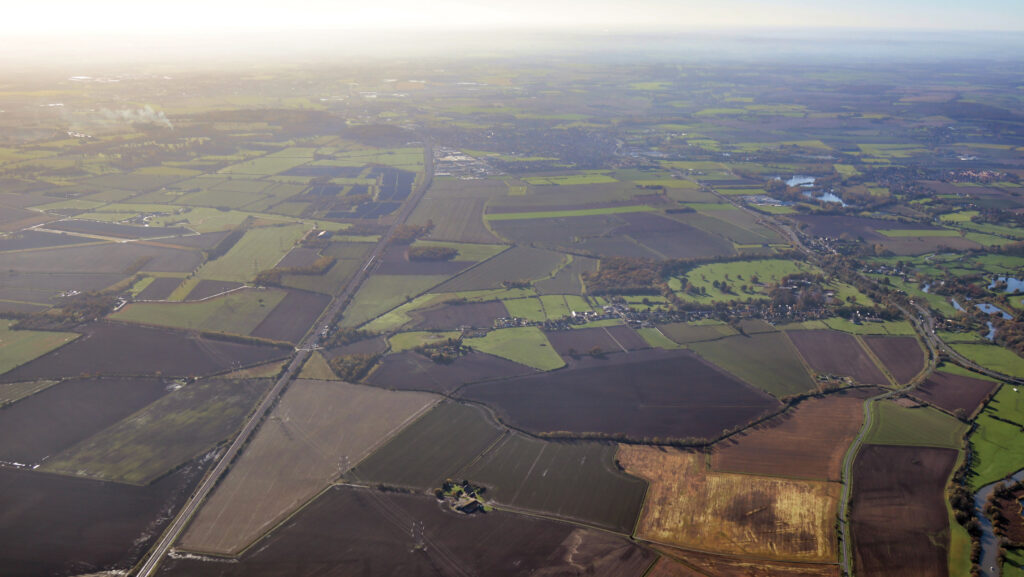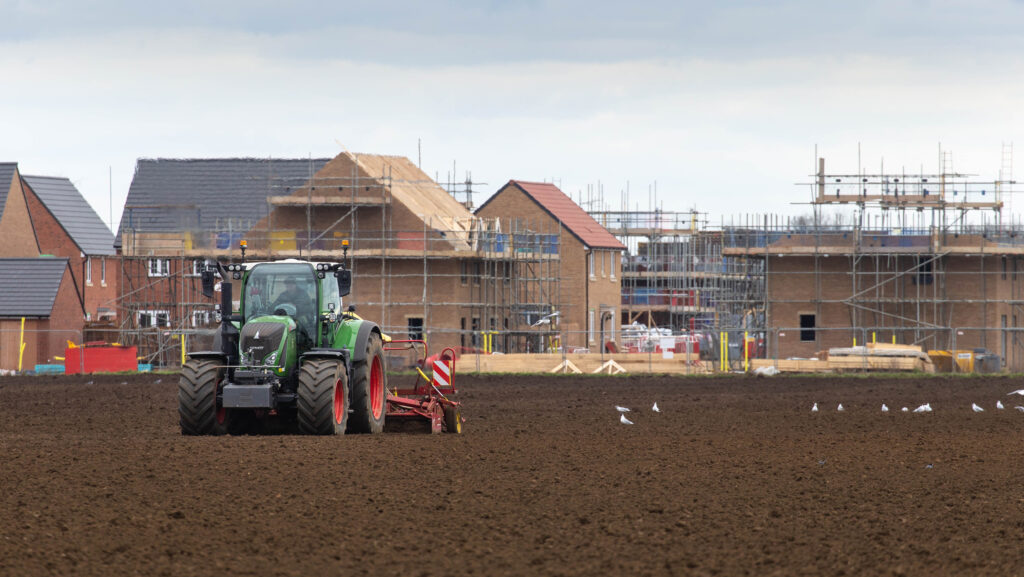Government plans for new towns: implications for farmland
 An aerial view of the proposed Tempsford site © Urban Civic
An aerial view of the proposed Tempsford site © Urban Civic Many of the 12 sites earmarked for potential new town developments are urban or regeneration sites, including a former military compound.
However, four are on greenfield sites and farmland will be needed to some extent for a good number of the remainder.
The most likely route to achieve the government’s ambition is through the creation of development corporations which, as in the past, will have compulsory purchase powers.
See also: Planning bill set to change environmental markets for farmers
Planners, developers and advisers are waiting for more concrete information from the government, expected next spring and including what the planning process will be for the new towns.
Land acquisition
Advisers point out that the task force recommended a “robust approach to land acquisition”, stating:
“This should include pooling of existing public land, negotiated acquisitions and compulsory purchase, and should be done at the earliest available opportunity to ensure that the government can capture land value uplift where possible.”
In response to this, the government stated:
“We are clear that where, despite reasonable efforts, it has not been possible to negotiate an agreement with landowners to acquire land, the relevant bodies will be able to make full use of their compulsory purchase powers where there is a compelling case in the public interest.
“The new town compulsory purchase guidance is clear that a fully developed new town scheme is not necessary to commence the compulsory purchase order proceedings.”
Where compulsory purchase is used, there is the provision for the “hope value” from potential development to be ignored in valuations.
Jeremy Moody, secretary and adviser to the Central Association of Agricultural Valuers, says that while the development corporations will have compulsory purchase powers, the sheer pressure of time will drive them to want to negotiate land acquisitions.
“Compulsory purchase involves delay and cost, and they [the government] are looking at approving the first three sites probably in spring 2026.
“Then they have got three years until 2029 [on the first three sites before the end of this parliament].”
He points out that the new towns programme comes against a very difficult background for developers, with fewer houses being built in a very challenged housing market, alongside workforce and skills shortages and environmental concerns.
Safeguarding can be imposed on land destined for new town development.
This is a mechanism that could be used by government or development corporations to prevent other competing development on land targeted for new towns or other infrastructure projects.
Environmental assessments
Responding to the task force report, the government has begun a strategic environmental assessment (SEA) to understand the environmental implications of new towns development.
No final decisions on locations will be made until that SEA concludes and preferred locations could change, it says.
There will be public and environmental challenges to the plans and the practicalities will be huge, says Jeremy.
“Nature trumps everything – so if you have something that damages nature, it can only go ahead if there is an imperative public interest.”
Mitigation will have to be found for environmental damage caused by the developments, widening the market for biodiversity net gain opportunities on farmland outside but mainly close to the developments.
Land take
Regeneration project housing density will be greater than on than greenfield sites but as a rule of thumb, 35 dwellings a hectare is a typical density on a greenfield development, says Charlie Collins, head of Savills’ planning office.
Using this measure, a new town of 10,000 units would take 285ha.
However, Charlie points out that once roads, open space and other community services are accounted for, this roughly doubles the land take.
Much detail is yet to come from the government, in particular regarding the mechanism for the planning process.
However, he says planning for the new towns is likely to be in outline.
Detailed consent would then be granted in stages as these large sites cannot be constructed as one project, nor can a detailed application be put together on this scale.
The new towns will bring challenges for water, energy and other service providers, as 70% of local plans are out of date and so these service providers have nothing to go on in terms of forward planning, says Charlie.

© Tim Scrivener
Land values
While compulsory purchase cannot realistically be threatened en masse, targeted locations will feel the force of this to a degree, says Richard Ford, a partner and planning and compulsory purchase specialist with law firm Pinsent Masons.
“Some farmers and landowners might be minded to sell before the disapplication of hope value starts to bite,” he says, pointing out that compulsory purchase for new towns is not a new concept, having been used in the 1960s and 1970s.
Where land in a potential new town target area is already under an option, or promotion agreement, there may be difficulties in renewing this, he suggests, if there is a safeguarding order or a real threat of compulsory purchase.
“Others in a target area may want to promote the value of their land to try and defend against potential compulsory purchase, or at least to test the value of their land on the open market to establish value,” suggests Richard.
“They could look to promote their land to the local authority through the authority’s call for sites.
“There’s a history of some sites not being selected on the first go at this, but often they are accepted second time round, so the sooner you get going on this, the better.
“Landowners would then be looking to sell their land to the highest bidder or to developers with schemes most compatible with their retained land or other objectives.
“They should definitely give this some thought as part of a defence strategy.
“The key thing is to be able to say they are in a position to develop the land themselves if compulsory purchase for development looms, as that will make compulsory purchase more difficult.
“Planning permission and certificates of appropriate alternative development can also establish value above existing use value even if there is a risk of hope value being disregarded.
“It’s a worthwhile investment in formulating a strategy around this for farmers and landowners.”
Savills’ development director Matthew Jones, based in Leeds, says that if landowners show their land is deliverable for development they will make significant sums in the long term and that it’s only if land is held back that compulsory purchase may be brought to bear.
Those who may want to sell farmland before the new towns plans are settled can consider using an overage or clawback in the sale contract so that they benefit from any subsequent planning value uplift, he suggests.
Matthew also advises talking to other landowners in the area as joint promotion of land for development can bring benefits, and this is especially relevant given the scale of the new towns projects.
Potential new town sites
The three sites earmarked recently by the government where construction is likely to start before the end of this parliament are:
- Tempsford, Bedfordshire
- Leeds South Bank
- Crews Hill, Enfield, north London
Tempsford is a new settlement for which options are in place on about 855ha of farmland to build up to 7,000 homes.
Other sites that will take significant farmland if the development is pursued include Adlington (Cheshire East local planning authority) and Marlcombe in East Devon.
Further sites are:
- Heyford Park, Oxfordshire, where redevelopment of the former US Air Force base near Bicester has already started
- Worcestershire Parkway: expanded development at Wychavon
- Brabazon and West Innovation Arc, Bristol/South Gloucestershire
- Thamesmead, Greenwich, London
- Victoria North, Manchester
- Milton Keynes, Buckinghamshire: a “renewed town” proposal
- Plymouth, Devon.
New town ambitions
- A government task force has identified 12 potential sites, with the aim for work to begin on at least three by the end of this parliament
- The project aims to provide 300,000 homes with each site providing a minimum of 10,000 homes – and several well in excess of that
- Likely to be delivered through the creation of development corporations with wide-ranging powers
- At least 40% of the dwellings to be classed as affordable housing, with half of these available for social rent – a task force recommendation
- The Levelling Up and Urban Regeneration Act 2023 and the Planning and Infrastructure Bill provide the powers for the new towns and other planning measures
